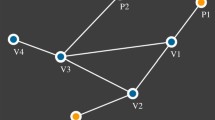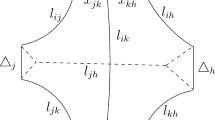Summary
We consider an eversion of a sphere driven by a gradient flow for elastic bending energy. We start with a halfway model which is an unstable Willmore sphere with 4-fold orientation-reversing rotational symmetry. The regular homotopy is automatically generated by flowing down the gradient of the energy from the halfway model to a round sphere, using the Surface Evolver. This flow is not yet fully understood; however, our numerical simulations give evidence that the resulting eversion is isotopic to one of Morin’s classical sphere eversions. These simulations were presented as real-time interactive animations in the CAVETM automatic virtual environment at Supercomputing’95, as part of an experiment in distributed, parallel computing and broad-band, asynchronous networking.
Access this chapter
Tax calculation will be finalised at checkout
Purchases are for personal use only
Preview
Unable to display preview. Download preview PDF.
Similar content being viewed by others
References
F. Apéry, An algebraic halfway model for the eversion of the sphere,Tohoku Math. J. 44 (1992), 103–150, with an appendix by B. Morin.
F. Apéry, Le retournement du cuboctaèdre, preprint, Institute de Recherche Mathématique Avancée, U. Louis Pasteur, Strasbourg, 1994.
T. Banchoff and N. L. Max, Every sphere eversion has a quadruple point, Contributions to Analysis and Geometry (Baltimore, MD, 1980) (D. N. Clark, G. Pecelli, and R. Sacksteder, eds.), Johns Hopkins Univ. Press, Baltimore, 1981, pp. 191–209.
R. Bargar, I. Choi, S. Das, and C. Goudeseune, Model-based interactive sound for an immersive virtual environment, Proceedings of the International Computer Music Conference (Aarhus, Denmark), International Computer Music Association, 1994, pp. 471–474.
K. A. Brakke The surface evolver, Experimental Mathematics 1 :2 (1992), 141–165.
K. A. Brakke and J. M. Sullivan, Using symmetry features of the surface evolver to study foams, Mathematics and Visualization (K. Polthier and H.-C. Hege, eds.), Springer Verlag, Berlin, 1996, pp. 95–117.
R. Bryant, A duality theorem for Willmore surfaces, J. Differential Geometry 20 (1984), 23–53.
C. Cruz-Neira, D. J. Sandin, T. A. Defanti, R. V. Kenyon, and J. C. Hart, The CAVE: Audio-visual experience automatic virtual environment,Communications ACM 35:6 (1992), 65–72.
G. Francis, A topological picturebook, Springer-Verlag, New York, 1987.
G. Francis, The hypergraphics honors seminar at Illinois, Scientific Visualization in Mathematics and Science Teaching (D. Thomas, ed.), Assoc. Adv. Comp. in Educ., Charlottesville, VA, 1995.
G. Francis, F. Apéry, C. Hartman, and G. Chappell, Equivariant sphere eversions, narrated videotape (9 min) produced at the NCSA, U. Illinois, 1992.
G. Francis and B. Morin, Arnold Shapiro’s eversion of the sphere, Math. Intelligencer 2 (1979), 200–203.
G. Francis, J. M. Sullivan, K. Brakke, R. Kusner, D. Roseman, A. Bourd, C. Hartman, G. Chappell, and J. Rubenstein, LATERNA matheMAGICA, Virtual Environments and Distributed Computing at SC’95: GII Testbed and HPC Challenge Applications on the I-WAY (H. Korab and M. D. Brown, eds.), ACM/IEEE Supercomputing’95, 1995.
A. Hanson, T. Munzner, and G. Francis Interactive methods for visualizable geometry,IEEE Computer 27:4 (1994), 73–83.
A. E. Hatcher, A proof of the Smale conjecture Diff (S 3) ≃ O(4), Annals of Math. 117 (1983), 553–607.
J. Hoffman and R. Kusner, Elastic surfaces and conformal geometry, video, produced at GANG, U. Massachusetts, Amherst, MA, 1992.
L. Hsu, R. Kusner, and J. M. Sullivan, Minimizing the squared mean curvature integral for surfaces in space forms, Experimental Mathematics 1:3 (1992), 191–207.
J. F. Hughes, Another proof that every eversion of the sphere has a quadruple point, Amer. J. Math. 107:2 (1985), 501–505.
J. F. Hughes, Polynomial models of smooth surfaces, presentation at the conference on Computer Graphics in Pure Mathematics (Dennis Roseman, organizer), U. Iowa and Inst. for Mathematics and its Applications, 1990.
R. Kusner, Conformal geometry and complete minimal surfaces, Bull. Amer. Math. Soc. 17 (1987), 291–295.
R. Kusner and N. Schmitt, The spinor representation of minimal surfaces, GANG preprint, 1994.
S. Levy, Making waves: A guide to the ideas behind Outside In, A K Peters, Wellesley, MA, 1995.
S. Levy, D. Maxwell, and T. Munzner, Outside In, A K Peters, Wellesley, MA, 1994, narrated videotape (21 min) produced by the Geometry Center, University of Minnesota.
P. Li and S. T. Yau, A new conformal invariant and its applications to the Willmore conjecture and the first eigenvalue of compact surfaces, Invent. Math. 69 (1982), 269–291.
N. L. Max, Turning a sphere inside out, International Film Bureau, Chicago, 1977, narrated videotape (21 min).
N. L. Max, Computer animation in mathematics, science,and art, Computers in Mathematics (D. V. Chudnovsky and R. D. Jenks, eds.), Lecture Notes in Pure and Applied Mathematics, vol. 125, Marcel Dekker, Inc., New York, 1990, includes as an appendix the illustrated guide to [25], pp. 321–345.
B. Morin, Équations du retournement de la sphére, Comptes Rendus Acad. Sci. Paris 287 (1978), 879–882.
B. Morin and J.-P. Petit, Le retournement de la sphère, Les Progrès des Mathématiques, Pour la Science/Belin, Paris, 1980, pp. 32–45.
A. Phillips, Turning a sphere inside out,Sci. Amer. 214 (1966), 112–120.
S. Smale, A classification of immersions of the two-sphere,Trans. Amer. Math. Soc. 90 (1959), 281–290.
T. J. Willmore, Note on embedded surfaces, An. Stunt. Univ “Al. I. Cuza” Iasi Sect. I, a Mat. 11 (1965), 493–496.
Author information
Authors and Affiliations
Editor information
Editors and Affiliations
Rights and permissions
Copyright information
© 1997 Springer-Verlag Berlin Heidelberg
About this chapter
Cite this chapter
Francis, G., Sullivan, J.M., Kusner, R.B., Brakke, K.A., Hartman, C., Chappell, G. (1997). The Minimax Sphere Eversion. In: Hege, HC., Polthier, K. (eds) Visualization and Mathematics. Springer, Berlin, Heidelberg. https://doi.org/10.1007/978-3-642-59195-2_1
Download citation
DOI: https://doi.org/10.1007/978-3-642-59195-2_1
Publisher Name: Springer, Berlin, Heidelberg
Print ISBN: 978-3-642-63891-6
Online ISBN: 978-3-642-59195-2
eBook Packages: Springer Book Archive




